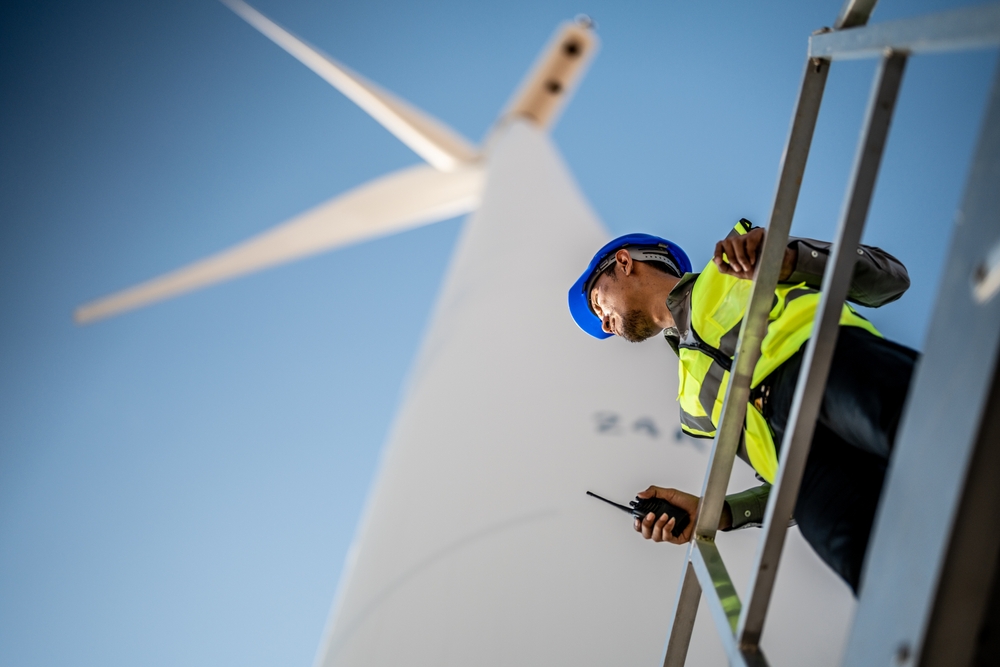The Philippines has a vast wind energy potential that can promote energy security, support sustainability goal and boost economic growth if harnessed right.
Key takeaways:
- The Philippines has an estimated 178,000 Megawatts of offshore wind potential, with strategic zones identified for development to meet the growing energy demand.
- Successful wind energy projects stimulate local economies, create jobs, encourage foreign investments and advance the country’s sustainable development and energy security goals.
- ACEN is leading the charge toward stronger wind power in the country, with four existing wind farms and more underway.
Situated along the Asia Pacific monsoon belt, the Philippines holds exceptional potential for wind energy development. Its geographic position exposes the country to strong and consistent wind flows throughout the year, both along its coasts and across its elevated inland regions.
According to data from the Philippine Atmospheric, Geophysical, Astronomical Services Administration or PAGASA, the country records an average wind power density of approximately 31 watts per square meter, while earlier studies by the U.S. National Renewable Energy Laboratory identified over 10,000 square kilometres of land with good-to-excellent wind resource potential. From the blustery ridges of Ilocos Norte to the coastal corridors of Guimaras, the potential is immense.
However, the future of wind energy in the Philippines rests on the nation’s ability to transform these abundant natural resources into long-term solutions for power generation. Wind power is just one of the renewable energy resources in the country that can help the country reduce its dependence on imported fuels, lower carbon emissions and provide access to energy security in more underserved areas.
Let’s look at how wind energy can become a cornerstone of the Philippines’ drive toward sustainability, energy security and inclusive development.

How can wind energy power the future of the Philippines
Wind power is more than a source of clean electricity. It is an enabler of economic resilience and long-term sustainability that impacts communities, industries and the national economy. How can wind energy help the Philippines?
Renewable and sustainable
Wind energy is fundamentally renewable because it harnesses a natural force that is constantly replenished. It’s not a finite resource, unlike fossil fuels.
Wind energy also produces no harmful emissions and requires no water to generate electricity. This is critical in a country facing the dual challenges of air pollution and water scarcity.
Clean energy is not only about reducing pollution today but ensuring a healthier environment for future generations. Compared with other energy sources, wind energy has the smallest environmental footprint. The energy needed to build and transport a wind turbine is typically recovered within a few months of operation.
By developing more wind farms as part of the country’s sustainability initiatives, the Philippines can take a critical step in reducing its greenhouse gas emissions, meeting climate commitments and protecting ecosystems.
Bolstering energy security
The Philippines remains heavily dependent on imported coal and oil, which exposes the country to price shocks and supply disruptions.
Wind farms diversify the energy mix and provide a locally generated, inexhaustible source of power. This strengthens national energy security.
In an archipelago of more than 7,000 islands, decentralizing power generation is vital in building an energy-secure future. Wind projects, especially in off-grid and remote areas, can help stabilize supply and reduce the frequency of outages.
Cost-effective resource
Although wind projects require significant upfront investment, the cost of generation can be recovered once they start commercial operations, provided there’s no major weather disturbances like typhoons, which could temporarily interrupt its generation potential.
The lifecycle of a wind turbine can also last up to 20 years, and during that period, it can produce energy without price fluctuations.
The long-term savings benefit the national economy, utilities and consumers. With global advances in turbine technology, wind energy is becoming one of the most cost-competitive forms of power generation.
Affordable for users
Consumers ultimately benefit when utilities shift toward renewables. Apart from being more accessible due to wind turbines’ geographic requirements (e.g., locations with high, consistent winds, such as coastal areas, mountain gaps and open plains), which allows remote communities access, wind energy is also more affordable.
By reducing exposure to volatile fuel imports, wind energy can make electricity prices stabilize in the Philippines. Over time, this translates into lower costs for households and businesses.
Affordable, stable electricity supports industrial growth, education, healthcare and other critical sectors. Communities that gain access to clean, affordable power also experience improved quality of life.
Job generation
Wind farms represent both infrastructure development and livelihood opportunities for local communities.
Wind energy development creates jobs for local communities at every stage, from construction and installation to operation and maintenance. Training opportunities equip workers with skills in a growing sector that will remain relevant for decades.
The construction of a wind farm stimulates local economies through supply chain activities, such as transport, fabrication and community services. All these developments show how wind energy can help empower different communities in the Philippines.
Foreign investments
Wind energy projects attract both domestic and international investors because they are anchored in long-term sustainability and backed by clear government policies.
For the Philippines, this influx of investment brings more than just financial capital. It accelerates infrastructure development, improves grid stability and creates opportunities for economic growth.
By positioning wind energy as a key pillar of the power mix, the country can strengthen its reputation as a forward-thinking, low-carbon economy and attract partners committed to long-term growth.
What does the future of wind energy look like in the Philippines?
The Philippines has already taken significant steps in developing wind power, but its potential remains largely untapped. Understanding the current state of the sector and the opportunities ahead reveals why wind energy is central to the country’s sustainable future.
The current state of wind energy in the Philippines
As of 2023, the Philippines has more than 400 megawatts (MW) of installed wind capacity, primarily concentrated in Northern Luzon. For instance, the 160 MW Pagudpud Wind is currently the largest wind farm in the Philippines and is an integral part of the country’s transition to renewable energy. Other operational projects by ACEN include the 52 MW NorthWind in Bangui, Ilocos Norte—the first wind farm in Southeast Asia and the 54 MW Guimaras Wind- the first wind farm in the Visayas.
Despite these successes, wind accounts for only a small portion of the country’s total power generation. Only 14.7% of the country’s power comes from wind, solar and other renewable sources. Fossil fuels still dominate the energy mix, with coal providing 59% of the national electricity supply. This underscores the need to accelerate investment in renewables to meet both rising demand and climate targets.
What is the future potential of wind energy in the Philippines?
The Philippines has an estimated 178,000 megawatts (MW) of wind energy potential, according to resource mapping studies conducted by the Department of Energy (DOE). The strongest wind corridors are in Ilocos, Northern Mindoro, Guimaras, Panay and parts of Mindanao. This capacity far exceeds the country’s current needs, presenting a clear opportunity to transition away from fossil fuels.
Government policy has begun to favor renewable energy resources, with measures such as the Renewable Energy Act of 2008 and the Green Energy Auction Program. The DOE has also set a target of increasing renewable energy’s share in the power mix to 50 percent by 2040. Wind energy is expected to play a critical role in meeting that goal.
ACEN is at the forefront of this transition. Our projects showcase how private sector leadership can align with government goals to drive large-scale change.

ACEN’s wind energy projects in the Philippines
As a wind power company and developer, ACEN has pioneered several of the Philippines’ landmark wind projects:
- North Luzon Renewables (Pagudpud, Ilocos Norte) – 81 MW wind farm delivering clean power to the Luzon grid.
- NorthWind (Bangui, Ilocos Norte) – 52 MW project, the first wind farm in Southeast Asia.
- Pagudpud Wind (Pagudpud, Ilocos Norte) – 160 MW, powering approximately over 60,000 homes, the largest wind farm in the country.
- Guimaras Wind (Guimaras, Western Visayas) – 54 MW, the first wind farm in Visayas.
- Capa Wind (Pagudpud, Ilocos Norte) – a wind farm underway, promising 70 MW of power.
With these trailblazing projects, ACEN is advancing not only the country’s energy security but also setting benchmarks for renewable energy across the region. Through innovation, partnerships and continued investment, the Philippines can position itself as a regional leader in wind energy.
A clean energy future within reach
What is the future development of wind energy in the Philippines? With its abundant wind resources, combined with supportive policies and visionary leadership from the private sector, wind energy can influence the Philippines’s future.
ACEN’s pioneering projects already serve as proof of what is possible. With continued collaboration between government, communities and renewable energy companies in the Philippines, we can accelerate toward a future where clean energy powers both progress and resilience.
Frequently Asked Questions
References:
- A Roadmap for Offshore Wind in the Philippines. (n.d.). World Bank. https://www.worldbank.org/en/news/infographic/2022/04/25/a-roadmap-for-offshore-wind-in-the-philippines
- Department of Energy Philippines. (2023a). Biomass, Solar, Wind And Ocean. https://legacy.doe.gov.ph/biomass-solar-wind-and-ocean
- Department of Energy, Republic of the Philippines. (n.d.b). PH Launches Comprehensive Guidebook to Boost Offshore Wind Energy Projects. https://legacy.doe.gov.ph/press-releases/ph-launches-comprehensive-guidebook-boost-offshore-wind-energy-projects
- Koons, E. (2024a, June 13). Air Pollution in the Philippines – Solutions. Energy Tracker Asia. https://energytracker.asia/air-pollution-in-the-philippines/
- Koons, E. (2024b, June 20). Water Pollution in the Philippines: Causes and Solutions. Energy Tracker Asia. https://energytracker.asia/water-pollution-in-the-philippines/
- Institute for Climate and Sustainable Cities & Institute for Energy Economics and Financial Analysis. (n.d.). Carving out coal in the Philippines: Stranded coal plant assets and the energy transition. https://icsc.ngo/resources-old/strandedcoal/
- International Energy Agency. (n.d.a). Philippines – Energy mix. https://www.iea.org/countries/philippines/energy-mix
- International Energy Agency. (n.d.b). Philippines – Coal. https://www.iea.org/countries/philippines/coal
- Piotrowska, K. et al. (2022). Assessment of the life Cycle of a Wind and Photovoltaic Power Plant in the Context of Sustainable Development of Energy Systems. Materials (Basel, Switzerland), 15(21). https://doi.org/10.3390/ma15217778
- One Planet Network. (n.d.). Renewable Energy Act of 2008 (RA 9513), Philippines. https://www.oneplanetnetwork.org/knowledge-centre/policies/renewable-energy-act-2008-ra-9513
- Piotrowska, K. et al. (2022). Assessment of the life Cycle of a Wind and Photovoltaic Power Plant in the Context of Sustainable Development of Energy Systems. Materials (Basel, Switzerland), 15(21). https://doi.org/10.3390/ma15217778
- Philippine Information Agency. (n.d.). DOE kicks off green energy auction for fixed-bottom offshore wind. https://pia.gov.ph/doe-kicks-off-green-energy-auction-for-fixed-bottom-offshore-wind/
- Philippine News Agency. (n.d.). DOE announces new milestones in renewable energy programs. https://www.pna.gov.ph/articles/1248488

